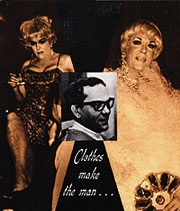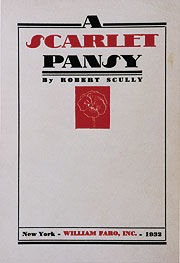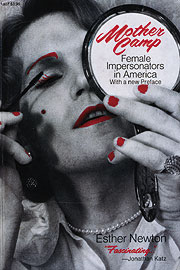Gay
studies at Chicago
 Gay
studies is a relatively young field, but homosexuality has long
been a subject of academic inquiry. A Regenstein Library exhibition
shows how generations of University of Chicago scholars have examined
the social and cultural processes that shape sexuality and the
study of it.
Gay
studies is a relatively young field, but homosexuality has long
been a subject of academic inquiry. A Regenstein Library exhibition
shows how generations of University of Chicago scholars have examined
the social and cultural processes that shape sexuality and the
study of it.
The
word homosexuality doesn't have a long history. The earliest
citation given in the Oxford English Dictionary dates from
1892--the year that the term homosexual was first used
in print by an American physician, Dr. James G. Kiernan of Chicago.
Also making its debut in 1892 was the University of Chicago. Within
two decades of its founding, U of C researchers had begun to study
homosexuality, in what has come to be seen as a distinctly Chicago
style. Their scholarship is the subject of "Homosexuality in the
City: A Century of Research at the University of Chicago," an
exhibition presented by the Department of Special Collections
at the Joseph Regenstein Library through December 15. The opening
was timed to coincide with "The Future of the Queer Past," a September
conference organized in large part by the Lesbian and Gay Studies
Project and the history department.
Over
the past decade, the U of C has become a center for research in
lesbian, gay, and queer studies, but as the exhibition's curator,
Chad
Heap, AM'93, PhD'00, an assistant professor
of American studies at George Washington University, points out
in the accompanying catalog, "[T]he study of homosexual life and
culture is hardly a new phenomenon at the University. Rather it
is a field with a long and complicated history on campus-one that
has been shaped as much by the social and political climate of
the city and nation as by the disciplinary fields in which it
has been pursued."
 Shifting
with society's views of homosexuality-from medical illness to
social deviance to psychological disorder to a field of study
in its own right-the research at Chicago dates to March 1910,
when several U of C sociologists and clergymen were named to the
city's Vice Commission. Asked to investigate the growth of female
prostitution and recommend how this "social evil" might be cured,
the commission expanded its scope when it discovered a "definite
cult" of feminine men and female impersonators at the city's music
halls and saloons. The commission urged lawmakers both to criminalize
certain homosexual offenses and to consult with "scientific men"
to learn how best to solve the problem.
Shifting
with society's views of homosexuality-from medical illness to
social deviance to psychological disorder to a field of study
in its own right-the research at Chicago dates to March 1910,
when several U of C sociologists and clergymen were named to the
city's Vice Commission. Asked to investigate the growth of female
prostitution and recommend how this "social evil" might be cured,
the commission expanded its scope when it discovered a "definite
cult" of feminine men and female impersonators at the city's music
halls and saloons. The commission urged lawmakers both to criminalize
certain homosexual offenses and to consult with "scientific men"
to learn how best to solve the problem.
By
the 1920s, faculty work in social and sexual reform had helped
to encourage a developing interest in sociological studies. Led
by Robert E. Park and Ernest W. Burgess, PhD'13, students embarked
on detailed studies of urban neighborhoods and networks, an approach
that came to be known as the "Chicago School." A number of the
studies explored how social and sexual mores were transformed
by urban spaces and institutions, with some charting the growing
incidence of homosexuality in the city. Urban reformers soon realized
that the students' participant-observation techniques and knowledge
of the city's more marginal neighborhoods made them ideal anti-vice
investigators, and many were recruited by the Juvenile Protection
Agency.
 While
serving on a 1927-1928 commission to investigate the state's parole
system, Ernest Burgess and John Landesco, PhB'24, discovered an
intricate network of homosexual practices in Illinois penitentiaries
and reform schools, a network that included not only those incarcerated
for homosexual offenses but also men whose homosexual activities
seemed confined to their prison terms. In this case, rather than
analyzing the social organization of this sexual culture, the
researchers used the information to determine which prisoners
were the best bets for parole, concluding that the "situational"
homosexuals were far more likely than those jailed for homosexual
acts to commit additional crimes upon parole.
While
serving on a 1927-1928 commission to investigate the state's parole
system, Ernest Burgess and John Landesco, PhB'24, discovered an
intricate network of homosexual practices in Illinois penitentiaries
and reform schools, a network that included not only those incarcerated
for homosexual offenses but also men whose homosexual activities
seemed confined to their prison terms. In this case, rather than
analyzing the social organization of this sexual culture, the
researchers used the information to determine which prisoners
were the best bets for parole, concluding that the "situational"
homosexuals were far more likely than those jailed for homosexual
acts to commit additional crimes upon parole.
Less
research was done on lesbian relations, partly because of their
comparative lack of visibility and cultural conventions that permitted
more same-sex intimacy among women. In 1920, however, Katherine
Bement Davis, PhD 1900, began an extensive survey of
the sex lives of "normal" women. Published as The Factors in
the Sex Life of Twenty-two Hundred Women (1929), the study
found that more than 50 percent of single women (30 percent of
married women) had experienced some degree of homosexual involvement.
The
"pansy craze" of the early 1930s made gay life in Chicago, New
York, and other cities more visible and accepted. Lesbian salons
attracted sightseers to Towertown (now known as the Magnificent
Mile, it was then a bohemian district), while drag entertainers
were a feature at South Side clubs. The craze made its way into
popular literature, and novels with gay or lesbian themes--like
The Well of Loneliness (1928), Strange Brother (1931),
and A Scarlet Pansy (1932)--were read by homosexuals and
heterosexuals alike.
To
gauge the novels' popularity, sociology students canvassed almost
100 local rental libraries, finding that hundreds of copies had
been loaned out (sometimes delivered by messenger service to more
timid customers) in almost every part of the city. Meanwhile,
realist novelists like James
T. Farrell, X'29 (who took sociology courses at Chicago),
also depicted the city's gay world.
The
"pansy craze" was short-lived. As the Depression deepened, a series
of sex-crime panics made headlines in Chicago and elsewhere. While
U of C sociologists had urged the city's leaders to see homosexuality
in relation to the complex web of urban social conditions, by
the end of the 1930s, as psychology gained popularity, the local
authorities and the general public became convinced that homosexuality
could be best explained, and dealt with, in terms of individual
psychopathology.
During
the periodic panics, at least two faculty members (including the
well-known bisexual writer and social critic,
Paul Goodman, PhD'54, then a graduate student and instructor
in English) lost their jobs as a result of homosexual activities.
There was no across-the-board firing of gay or lesbian employees;
rather, administrators took action only against faculty members
whose public behavior had generated, or was about to generate,
unwanted publicity.
In
that atmosphere, research in homosexuality declined sharply. No
longer did students write papers documenting lesbian and gay life
or the life histories of their homosexual friends, nor did the
topic receive any substantive discussion in the University's sociology
courses.
The
one major sociological research project that examined homosexuality
in any depth during the 1940s reflected psychology's growing influence.
Writing his master's thesis, Earl
W. Bruce, PhB'35, AM'42, mixed documentation of the
city's homosexual world-nightspots, parties, and participants-with
a study of the personality traits of the homosexual man, placing
the results of his informants' personality tests within the context
of the social problems they faced as urban homosexuals. A decade
later, James
M. Sacks, PhB'47, AM'52, PhD'57, wrote a dissertation
based on an experiment designed to test Freud's hypothesis that
delusions of persecution originated in a fear of homosexuality,
but in general the psychological study of homosexuality gained
little enthusiasm.
In
the 1950s and early 1960s, U o f C sociologists returned to the
topic of homosexuality, this time emphasizing the construction
of social norms. Scholars like
Howard S. Becker, PhB'46, AM'49, PhD'51, and Erving Goffman, AM'49,
PhD'53, questioned the assumed pathology of homosexuals,
as well as the naturalness of social norms, arguing that homosexuality
received a "deviant" status because of rules and sanctions established
by society. As sociological studies of "social deviance" became
more influential, Chicago scholars began to reexamine urban homosexual
communities as complex social structures produced in response
to social stigma and regulation.
Nationally,
gay studies emerged as a field of its own in the 1990s, and Chicago
was no exception. In 1991, the history department became the second
history department in the nation to offer a tenure-track appointment
to a candidate with a gay-history dissertation: history professor
George Chauncey was that candidate, and his Gay New York: Gender,
Urban Culture and the Making of the Gay Male World, 1890-1940
(Basic Books, 1994) won the Frederick Jackson Turner Award of
the Organization of American Historians. Since Chauncey's hiring,
graduate students in a dozen departments have completed or are
writing dissertations related to the field. And although some
of those works are in the humanities, the research at Chicago
continues to be marked by a concern with the social, cultural,
and urban processes that shape sexuality.
Meanwhile,
in 1992, sociologists Edward
O. Laumann; Robert T. Michael; John H. Gagnon, AB'55, PhD'69;
and Stuart K. Michaels, PhD'97; undertook a major quantitative
survey of adult sexual behavior. Its controversial finding-that
only 1.4 percent of women and 2.8 percent of men identified themselves
as homo- or bi-sexual-challenged the widespread belief that lesbians
and gay men composed 10 percent of the nation's population and
was greeted with some skepticism, prompting a continuing debate
on the study's methodology and interpretations.
The
Lesbian and Gay Studies Project, an interdisciplinary group led
by Chauncey and anthropology professor Elizabeth Povinelli, was
established in 1997 by the Center for Gender Studies. Besides
funding dissertation-year fellowships and research grants, the
project sponsors conferences and seminars, and it coordinates
the decade-old Gay, Lesbian, and Queer Studies Workshop, a biweekly
gathering where faculty and graduate students discuss their works
in progress or papers presented by visiting scholars.
The
University of Chicago Press, which in the early 1980s published
two landmark works in the historical study of homosexuality--John
Boswell's Christianity, Social Tolerance, and Homosexuality
(1980) and John D'Emilio's Sexual Politics, Sexual Communities
(1983)-has developed a list covering nearly every aspect of
the field: anthropology, art, history, law, literature, politics,
psychology, religion, and sociology. The list's breadth and depth
make it clear that there are many veins to mine.

![]()
 Gay
studies is a relatively young field, but homosexuality has long
been a subject of academic inquiry. A Regenstein Library exhibition
shows how generations of University of Chicago scholars have examined
the social and cultural processes that shape sexuality and the
study of it.
Gay
studies is a relatively young field, but homosexuality has long
been a subject of academic inquiry. A Regenstein Library exhibition
shows how generations of University of Chicago scholars have examined
the social and cultural processes that shape sexuality and the
study of it. Shifting
with society's views of homosexuality-from medical illness to
social deviance to psychological disorder to a field of study
in its own right-the research at Chicago dates to March 1910,
when several U of C sociologists and clergymen were named to the
city's Vice Commission. Asked to investigate the growth of female
prostitution and recommend how this "social evil" might be cured,
the commission expanded its scope when it discovered a "definite
cult" of feminine men and female impersonators at the city's music
halls and saloons. The commission urged lawmakers both to criminalize
certain homosexual offenses and to consult with "scientific men"
to learn how best to solve the problem.
Shifting
with society's views of homosexuality-from medical illness to
social deviance to psychological disorder to a field of study
in its own right-the research at Chicago dates to March 1910,
when several U of C sociologists and clergymen were named to the
city's Vice Commission. Asked to investigate the growth of female
prostitution and recommend how this "social evil" might be cured,
the commission expanded its scope when it discovered a "definite
cult" of feminine men and female impersonators at the city's music
halls and saloons. The commission urged lawmakers both to criminalize
certain homosexual offenses and to consult with "scientific men"
to learn how best to solve the problem.  While
serving on a 1927-1928 commission to investigate the state's parole
system, Ernest Burgess and John Landesco, PhB'24, discovered an
intricate network of homosexual practices in Illinois penitentiaries
and reform schools, a network that included not only those incarcerated
for homosexual offenses but also men whose homosexual activities
seemed confined to their prison terms. In this case, rather than
analyzing the social organization of this sexual culture, the
researchers used the information to determine which prisoners
were the best bets for parole, concluding that the "situational"
homosexuals were far more likely than those jailed for homosexual
acts to commit additional crimes upon parole.
While
serving on a 1927-1928 commission to investigate the state's parole
system, Ernest Burgess and John Landesco, PhB'24, discovered an
intricate network of homosexual practices in Illinois penitentiaries
and reform schools, a network that included not only those incarcerated
for homosexual offenses but also men whose homosexual activities
seemed confined to their prison terms. In this case, rather than
analyzing the social organization of this sexual culture, the
researchers used the information to determine which prisoners
were the best bets for parole, concluding that the "situational"
homosexuals were far more likely than those jailed for homosexual
acts to commit additional crimes upon parole.